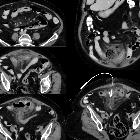juxtapapilläres Duodenaldivertikel

Großes
juxtapapilläres Divertikel des Duodenums. Das Divertikel wurde endoskopisch bestätigt und die Papille lag am Rand dieses Divertikels. Das Divertikel war mit Speiseresten angefüllt, am Rand fanden sich Schleimhautulzerationen.

Juxtapapilläres
Duodenaldivertikel in der ERCP: Das Duodenum und das Divertikel sind über das Endoskop deutlich luftgefüllt. Die Sondierung der Papilla Vateri am Rand eines Divertikels ist in einer solchen Situation oft erheblich erschwert. Die Projektion erfolgte bei schräger Bauchlage a.p.; das Bild ist für die Betrachtungsrichtung von ventral gespiegelt.

Periampullary
diverticulum • Periampullary duodenal diverticulum - Ganzer Fall bei Radiopaedia

Periampullary
diverticulum • Periampullary diverticulum - Ganzer Fall bei Radiopaedia

Periampullary
diverticulum • Periampullary diverticulum - Ganzer Fall bei Radiopaedia

Periampullary
diverticulum • Lemmel syndrome - Ganzer Fall bei Radiopaedia

Periampullary
diverticulum • Periampullary duodenal diverticulum - Ganzer Fall bei Radiopaedia
A periampullary diverticulum is a location-specific type of duodenal diverticulum.
Epidemiology
The incidence is reported to increase with age with reported rates as high as 27%.
Pathology
It is located close to the region of the duodenum often involving the D2 segment.
Associations
- can be associated with increased risk of failure for cannulation of the papilla.
- associated with an incompetent sphincter of Oddi and colonization of bile duct with beta-glucuronidase-producing organisms.
- they are implicated in the pathogenesis of pigment common bile duct stones, but there is no conclusive evidence that they are associated with cholecystolithiasis or pancreatitis.
Related pathology
Siehe auch:

 Assoziationen und Differentialdiagnosen zu juxtapapilläres Duodenaldivertikel:
Assoziationen und Differentialdiagnosen zu juxtapapilläres Duodenaldivertikel:

